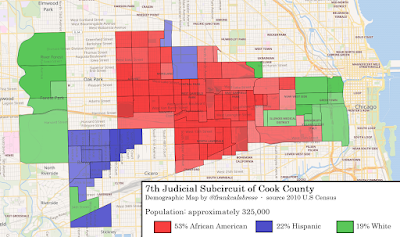by Frank Calabrese
Judicial appointments by the Illinois Supreme Court are typically sleepy affairs, and the media responds to an appointment with a yawn. This month however a media storm erupted when Supreme Court Justice Anne M. Burke recommended the appointment of Cara LeFevour Smith to a 7th Subcircuit vacancy, resulting in unusually intense scrutiny. All the local television networks and daily papers covered the “controversy” of the Supreme Court appointing Judge Cara Smith. The CBS story was entitled “Judicial Appointee 'A Slap In The Face' To Represent The West Side”. The media coverage was largely premised on the idea that 7th Judicial Subcircuit is an African-American political district and the Supreme Court was disenfranchising minority residents by appointing a white woman to that district.
The 7th Subcircuit was created with the intent to elect more African-American judges. However, the makeup of the 7th Subcircuit has changed a lot since it was created in the early 90’s. Today's West Loop neighborhood is considerably different than it was when first included within the 7th Subcircuit boundaries. This post does not address the prudence of the appointment of Judge Cara Smith, but rather to help the media and readers of this blog to understand why a white woman won the 7th subcircuit in 2016 and how candidates should now approach this subcircuit.
As of the 2010 Census, the 7th Judicial Subcircuit was still majority African American, around 53%. However, with the construction boom in the west loop and the continued depopulation of the west side of Chicago west of Western Avenue, I would estimate that the district is no longer majority African-American, but rather a plurality. The district is extremely segregated, with River Forest, Forest Park, and the west loop east of Ashland being white, Berwyn being Hispanic, and the core of the district, the west side of Chicago, being African-American, with many census tracts reading 100% African-American. The district makes little sense today and if redrawn today, it would certainly look very different so that it could be again be a truly African American district.
The 2016 7th Subcircuit election was interesting for many reasons. One is that all the candidates were well known in the legal community. Two of the candidates, Judge Pat Spratt and Judge Rosa Silva, are now judges and another, Jennifer Ballard, is the chief of staff to the State’s Attorney. It is also notable that a white woman, Judge Spratt, won in a district that was designed to elect an African-American judge. In this election, Pat Spratt won with an odd coalition of white votes and support in Austin and the 37th ward. Judge Spratt was supported by Alderman Emma Mitts and had organizational support in Austin. Rosa Silva did very well by winning big in Berwyn and white areas. Julianna Ballard won in the 28th and 27th wards, where she was supported by the local aldermen.
I hope this post clears up some confusion in the media and readers of this blog. Yes, the 7th Subcircuit was designed and intended to elect African-American judges. However, the subcircuit has changed so much since the 90’s that the state legislature should redraw it so that it can again reliably elect African-American judges. I would recommend removing the Berwyn portion of the 7th subcircuit and uniting Berwyn into the 14th subcircuit (which would further make the 14th Subcircuit a Latino subcircuit). Further, I would include Maywood to the west in the 7th Subcircuit and I would remove the west loop neighborhood and include it with a white majority subcircuit (likey a redrawn 6th or 8th Subcircuit).
--------------------------------------------------------------------------------
Ed. note: Frank Calabrese is a political researcher and consultant. FWIW offers no opinion about Frank's proposed redrawn boundaries. However, the boundaries of all 15 Cook County judicial subcircuits will be withdrawn after the 2020 Census, pursuant to the provisions of HB2625, passed during the most recent legislative session. At last report, the bill was still awaiting the Governor's signature, but that is expected imminently. (For prior FWIW coverage on HB2625, click here).

























